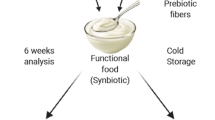Abstract
The viability of lyophilized cultures of Lactobacillus bulgaricus in skim milk, during storage at different temperatures, relative humidities, and atmospheres was investigated. Survival was greatest at 11% relative humidity and at 5°C. Indirect and direct evidence is presented supporting the hypothesis that membrane damage occurs during storage. Experiments on the lipid composition of the cell membrane demonstrate that changes occur with time that are probably the result of oxidation. A study on the lipid composition of the cell membrane by gas chromatography showed that the unsaturated/saturated fatty acid index changes with time during storage.
Similar content being viewed by others
References
Anonymous (1961) The drying operation. The accelerated freeze-drying (AFD) method of food preservation. Ministry of Agriculture, Fisheries and Food, Pinner, UK
Asada S, Takano M, Shibaski I (1980) Methods for prevention of breakage of DNA strands and mutation induction caused by cell drying in Escherichia coli. Hakkokoguko Kaishi 58:423–430
Carlsson J, Nyberg G, Wrethén J (1978) Hydrogen peroxide and superoxide radical formation in anaerobic broth exposed to atmospheric oxygen. Appl Environ Microbiol 36:223–229
Champagne CP, Detournay H, Hardy MJ (1991) Effect of medium on growth and subsequent survival, after freeze-drying, of Lactobacillus delbrueckii subsp. bulgaricus. J Ind Microbiol 7:147–150
Clementi F, Rossi J (1984) Effect of drying and storage conditions on survival of Leuconostoc oenos. Am J Enol Vitic 35:183–186
Couture R, Gagné D (1991) Effect de divers additifs sur la survie à la lyophilization de Lactococcus lactis. Can Inst Sci Technol J 24:224–227
De Man JCA, Rogosa M, Sharpe ME (1964) Medium for the cultivation of lactobacilli. J Appl Bacteriol 23:130–136
Foster EM (1962) Culture preservation. J Dairy Sci 45:1290–1294
Girotti AW, Thomas JP (1984) Damaging effects of oxygen radicals on resealed erythrocyte ghots. J Biol Chem 259:1744
Halliwell B, Gutteridge JMC (1984) Oxygen toxicity, oxygen radicals, transition metals and disease. Biochem J 219:1–14
Ishibashi N, Tatematsu T, Shimamura S, Tomita M, Okonogi S (1985) Effect of water activity on the viability of freeze-dried bifidobacteria and lactic acid bacteria. Refrig Sci Technol 1:227–232
Israeli E, Kohn A (1972) Protection of lyophilized Escherichia coli from oxygen by colicin E1 treatment. FEBS Lett 26:323–326
Karel M (1980) Lipid oxidation, secondary reactions and water activity of foods. In: Simic MG, Karel M (eds) Autoxidation in food and biological systems. Plenum press, New York
Lion MB, (1963) Quantitative aspects of protection of freeze-dried Escherichia coli against the toxic effect of oxygen. J Gen Microbiol 32:321
Mackey BM, Seymour DA (1987) The effect of catalase on recovery of heat-injured DNA repair mutants of Escherichia coli. J Gen Microbiol 21:119–122
Miles AA, Misra SS (1936) The estimation of the bactericidal power of blood. J Hyg (Cambridge) 38:732–749
Morich T (1974) Preservation of lactic acid bacteria by freeze-drying Jpn Agric Res Q 8:171
Naylor HB, Smith PA (1946) Factors affecting the viability of serratia marcescens during dehydration and storage. J Bacteriol 52:565
Onishi T, Tanaka Y, Yoh M, Takeda Y, Miwatani T (1977) Deoxyribonucleic acid strand breaks during freeze-drying and their repair in Escherichia coli. J Bacteriol 130:620–628
Pryor WA (1971) Free radical Chem Eng News 49:34
Rozès N, Garbay S, Denayrolles M, Lonvaud-Funel A (1993) A rapid method for the determination of bacterial fatty acid composition. Lett Appl Microbiol 17:26–131
Santiago E, López-Moratalla N, Segovia JL (1973) Correlation between losses of mitochondrial ATPase activity and cardiolipin degradation. Biochem Biophys Res Commun 53:439–445
Scott WJ (1958) The effect of residual water on the survival of dried bacteria during storage. J Gen Microbiol 19:624–633
Sinskey AJ (1971) Current status of injury in freeze-dried microorganisms. J Milk Food Technol 34:551–552
Slater TF (1984) Free-radical mechanisms in tissue injury. Biochem J (review article) 222:1–15
Sogin SJ, Ordal ZJ (1967) Regeneration of ribosomes and ribosomal ribonucleic acid during repair of thermal injury to Staphylococcus aureus. J Bacteriol 94:1082–1087
Yang NL, Sandine WE (1979) Acid-producing activity of lyophilized lactic streptococcal cheese starter concentrates. J Dairy Sci 62:908–915
Author information
Authors and Affiliations
Rights and permissions
About this article
Cite this article
Castro, H.P., Teixeira, P.M. & Kirby, R. Storage of lyophilized cultures of Lactobacillus bulgaricus under different relative humidities and atmospheres. Appl Microbiol Biotechnol 44, 172–176 (1995). https://doi.org/10.1007/BF00164498
Received:
Revised:
Accepted:
Issue Date:
DOI: https://doi.org/10.1007/BF00164498




